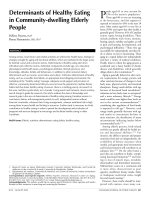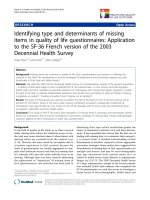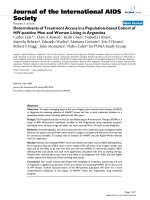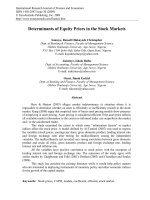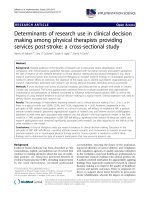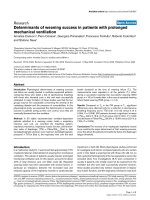Determinants of the number of hours doing housework of the wives in tow earner households in urban HCM city
Bạn đang xem bản rút gọn của tài liệu. Xem và tải ngay bản đầy đủ của tài liệu tại đây (3.03 MB, 85 trang )
THE UNIVERSITY OF ECONOMICS
INSTITUTE OF SOCIAL STUDIES
HO CHI MINH CITY
THE HAGUE
VIETNAM
THE NETHERLANDS
THE VIETNAM-NETHERLANDS PROJECT FORMA PROGRAM
-
/
IN DEVELOPMENT ECONOMICS
DETERMINANTS OF THE NUMBER OF HOURS
DOING HOUSEWORK OF THE WIVES IN TWO-EARNER
HOUSEHOLDS IN URBAN HO CHI MINH CITY
BY
LUONG THI CHUNG THUY
IN PARTIAL FULFILLMENT OF THE REQUIREMENTS FOR THE DEGREE
OF MASTER OF ARTS IN ECONOMICS OF DEVELOPMENT
HO CHI MINH CITY, 2003
CERTIFICATION
I certify that the substance of this dissertation has not already been submitted for any degree
and is not being currently submitted for any other degree.
I certify that to the best of my knowledge, any help received in preparing this dissertation, and
all sources used, have been acknowledged in this dissertation.
Luong Thi Chung Thuy
Date: September 81h, 2003
ACKNOWLEDGEMENT
The thesis in done as the fulfillment of the MA course of Vietnamese - Dutch Project for
Development Economics. Thanks to the Netherlands for her Aid and Scholarship during the
course.
I would like to thank Dr Gabrielle Berman, Dr Youdi Schipper and Dr Karel Jansen for their
worthy teaching, suggestion and comments on my very first step of the thesis.
I would like to express my special thanks to my supervisor, Dr Ho Ngoc Phuong, for his
supervising and guidance during my writing. I am deeply indebted to MA Ta Thi Bich Thuy for
her special support and all materials she gave. Many thanks are also given to Dr Nguyen Van
Ngai for his suggestion on my thesis econometric model, Dr Nguyen Thi Hoa, Dr Tran Kim
Dung for their helps. The thesis would not have been completed without their support and
encouragement.
Many thanks are also given to all project teachers and staffs, especially Mr Tran Vo Hong Son,
Ms Tran Thi Ben, Ms Do Thi Anh Nguyet and Ms Dang Kim Chi for their helping during the
course.
I would like to thank Ms Dang Le Hoa for her checking of my writing in grammar, vocabulary
as well as her comments. I also thank Ms Nguyen Phuong Chi, Ms Ha Dung, Ms Pham Le Hoa,
Ms Doan Thi Thu Huong, Mr Luu Tien Thuan, Mr Truong Khoa (RAND), and Ms Nguyen
Thanh Binh (DOLISA), who gave me many supports in doing the thesis. My sincere gratitude
goes to all of my friends for their helping and discussions.
I am also grateful to all people who helped me conducting the survey, especially Ms Phan Hong
Ha, Mr Nguyen Thanh Tung, other staffs and interviewers at ACORN Company. I also thank
all of respondents who gave me valuable information.
Finally, I am thankful to my parents, my aunt·and my brother for their special supports. I
cannot do anything without their supports and encouragement.
11
ABSTRACT
The study tries to examine the determinants of the number of hours doing housework of the
wives in two-earner households in urban Ho
C~i
Minh City. The study based on the theories of
household behaviour and time allocation to test the effects of women and households'
characteristics on the number of housework hours of the wives. The Ordinary Least Square
regression and descriptive method are employed in the research.
The findings are that the higher their earnings, the less hours of housework they do; the more
young children (aged less than 15) they have, the more hours of housework they do. Moreover,
the number of housework hours of the wives has negative relation with the number of other
adult female in households. Furthermore, the involvement in housework of husbands proves to
be the significant determinant of the number of hours doing housework of the wives. However,
the wives' age, the educational level of both spouses, expenditure per capita, appliance of
modern equipment in home production, and number of other adult male in households have no
significant relationship to the number of hours doing housework of the wives.
l11
TABLE OF CONTENTS
CERTIFICATION ........................................................................................:............. 1
ACKNOWLEDGEMENT ..............................................................................! ........... 11
ABSTRACT ............................................................................................................ 111
TABLE OF CONTENTS ........................................................................................ IV
ABBREVIATIONS ................................................................................................ VII
LIST OF TABLES ................................................................................................ VIII
LIST OF FIGURES ................................................................................................ IX
CHAPTER 1: INTRODUCTION ............................................................................... 1
1.1
PROBLEM STATEMENT ..................................... :......................................................................... l
1.2
SCOPE OF THE RESEARCH ......................................................................................................... 3
1.3
OBJECTIVES OF THE STUDY...................................................................................................... 3
1.4
RESEARCH METHODOLOGY AND DATA COLLECTION ................................................... 4
1.5
THESIS' STRUCl"URE .................................. ,...................................................... ,,,,,,,,,,,,., ... ,,,,,,,,,, 5
CHAPTER 2: LITERATURE REVIEW .................................................................... 6
IV
2.1
DEFINITIONS ................................................................................................................................... 6
2.1.1
Household ....................................................................................................................................... 6
2.1.2
Time allocation ................................................................................... .'........................................... 7
THE THEORETICAL BACKGROUND ........................................................................................ 8
2.2
2.2.1
The economics of household behaviour ......................................................................................... 9
2.2.2
A work-leisure model of household .............................................................................................. 10
2.2.3
The theory of time allocation ........................................................................................................ 12
2.2.4
Division of work within household ........................................................................ .'..................... 15
2.2.5
Human capital theory .................................................................................................................... 16
2.3
THE EMPIRICAL REVIEWS ....................................................................................................... 17
2.3.1
In developed nations ..................................................................................................................... 17
2.3.2
In developing countries ................................................................................................................. 19
CHAPTER 3: MODEL SPECIFICATION ............................................................... 26
3.1
THE VARIABLE JUSTIFICATION ............................................................................................. 26
3.2
THE MODEL SPECIFICATION .............. ,................................................................................... 30
3.3
THE SAMPLE SIZE ....................................................................................................................... 30
3.4
SAMPLING AND DATA COLLECTION METHOD ................................................................. 31
. CHAPTER 4:
DETERMINANTS OF NUMBER OF HOUSEWORK HOURS OF
MARRIED WORKING WOMEN IN TWO-EARNER HOUSEHOLDS IN HO CHI
MINH CITY
4.1
..................................................................................................... 33
A GLANCE AT HO CHI MINH CITY .............................................................................................. 33
v
I
4.1.1
General Socio Economic .............................................................................................................. 33
4.1.2
Profile of women ofHo Chi Minh City ........................................................................................ 34
4.2
DETERMINANTS OF NUMBER OF HOUSEWORK HOURS ................................................ 38
4.2.1
Descriptive analysis ...................................................................................................................... 39
4.2.1.1 Numerical summaries of variables .............................................................................................. 39
4.2.1.2 Pattern of time allocation ............................................................................................................ 39
4.2.1.3 Bivariate analysis ........................................................................................................................ 41
4.2.2
Quantitative analysis using econometric model... ......................................................................... 47
4.2.2.1
Regression results: ................................................................................................................... 47
4.2.2.2
Diagnostic testing for regression ............................................................................................. 49
4.2.2.3
Interpretation of coefficients and regression results ................................................................ 50
CHAPTER 5
CONCLUSION AND POLICY IMPLICATIONS .......................... 56
5.1
BRIEF SUMMARIES OF THE THESIS FINDINGS .................................................................. 56
5.2
POLICY IMPLICATIONS ............................................................................................................. 57
APPENDICES ....................................................................................................... 59
BIBLIOGRAPHY ................................................................................................... 71
vi
ABBREVIATIONS
DO LISA
Department of Labour, Invalid, and Social Affair
HCM
Ho Chi Minh City
GSO
General Statistical Office
GDP
Gross Domestic Products
MOLISA
Ministry of Labour, Invalid, and Social Affair
OLS
Ordinary Least Squares
UNDP
United Nations Development Programme
VLSS
Vienam Living Standard Survey
vii
LIST OF TABLES
Table 2.1
Summary of selected empirical studies of time allocation of housework ......... 24
Table 3.1
Definitions ofvariables ...................................................................................... 29
Table 4.1
Percentage of households getting amenities of home life .................................. 34
Table 4.2
Female labour divided by age groups ................................................................ 3 5
Table 4.3
The active female aged from 15 divided by educationallevel .......................... 36
Table4.4
Sumtnary of variables ........................................................................................ 39
Table 4.5
Pattern of weekly time allocation of spouses .................................................... 40
Table 4.6
Weekly housework hours of the spouses .......................................................... .40
Table 4.7
The number of hours of housework by wives' educationallevel ...................... 43
Table 4.8
The time used for housework according to the wives' age ................................ 43
Table 4.9
Pattern of housework homs by household size .................................................. 44
Table 4.10
The effect of the presence of children aged 0-15 in the housework hours ....... .45
Table 4.11
The housework activities with respect to the domestic help ............................ .46
Table 4.12
The OLS regression results ................................................................................ 49
viii
LIST OF FIGURES
Figure 2.1
The choice between Consumption and Leisure ................................................. 11
Figure 4.1
The unemployment rate in urban Ho Chi Minh City in 1996-2002 .................. 37
Figure 4.2
The relationship between housework hours and wives' earJlings ...................... 42
Figure 4.3
The relationship between housework hours and market hours of wives ........... 42
Figure 4.4
The relationship between housework hours and wives' age ............................ .44
Figure 4.5
The relationship between number of housework hours of wives and number of
housework hours of husbands ..................................................................................................... 4 7
IX
CHAPTER 1: INTRODUCTION
1.1
PROBLEM STATEMENT
In the 1990s, the world, especially the developing countries has experienced great
achievements in economic development. It is not only the achievements in economic growth,
but also the improvement in the living standard of human beings, poverty and inequality
reduction (UNDP, 1997). However, women seem to be less benefited from such achievements
as claimed by the United Nation that "women constitute half of the world's population and
performed nearly two-third of the work hours, receive one-tenth of the work's income and own
less than one-hundredth of the world's property" (Yarr, 1994: 111).
Traditionally, within household women are assigned to work at home while men are .assigned to
work in the market to earn for the household (World Bank, 2001). Women become the
dependents of the men and thus they have few opportunities of participating in development
process and enjoying the development's achievements (World Bank, 2001). The work of
women at home is not considered as 'work' just because it is unpaid and then its contribution to
the total welfare of household is ignored.
In the modern society, together with the industrial innovation and women liberalization waves
more women enter market work. They in fact accomplish great achievements in many fields
and their human characteristics and status are also improved (Alvarez· and Miles, 2002).
However, they still have to maintain all the unpaid housework so that they are more burdened
by dual work (World Bank, 2001). Their load of work will increase when they get married and
have children (Biau and Ferber, 1992). Due to the time constraint, time available for activities
such as leisure, schooling and housework must be reduced as a result of an increase in time
spent for paid work and social work. However, which one will be reduced? Does time of doing
housework reduce?
'
Vietnam has achieved rapid economic growth since the Doimoi policy implemented in 1986.
Despite its great achievements, the inequality seems to rise (Gallup, 2002). In recent years, the
issU((S of gender division of family labour at home have been paid much attention to. Some
studies of time allocation of household members found that Vietnamese women are overloaded
with disproportionate burden of housework (World Bank, 1999a) Vietnam female labor force
increased 12 percent from 25,228,859 up to 28,325,968 persons in 1996-2000 (MOLISA,
2001). The second Vietnam Living Standard Survey in 1997 showed that the annual average
hours of income-generating activities outside home are almost the same for both men and
women aged over 15. On average adult male spent 1464 hours per year and adult female spent
1420 hours per year for income-generating activities (Desai, 2000). Although the hours per
week that women spent on unpaid household activities had a trend to reduce from 15.52 hours
in 1992-1993 down to 12.75 hours in 1997-1998, their time spent for housework is nearly
double that of men (GSO, 1999:197, 199). Moreover, in the survey of six localities' (Ho Chi
Minh, Qui Nhon cities, Nam Dinh, Thai Binh, Dong Thap and Yen Bai provinces), it wasfound
that although there exists the increasing trend of sharing housework among couples, the large
proportion of housework still relies on the wives (Nguyen, 2000).
It seems that the reduction in household work cannot compensate for the increase in market
work and that women expand their work at the expense of their time for rest, training,
community activities and self-development (Yarr, 1994: 115). As a result, the heavy workload
may have the negative impact on women's health, and in the long run, may affect the quality of
their children (World Bank, 1999a). In other words, the women's traditional responsibilities
within households may limit their participation in the society (Long et al, 2000). It raises an
interesting issue that how to reduce women's burden workload and how to solve the confliction
between their full-time market work and traditional roles at home when they participate in the
paid employment outside home. The problem is whether the women really liberate from the
domestic chores within household when they increase the participation in the labour force,
especially for married women. It is interesting to examine, in this study, among various factors
such as economic factors, household characteristics and composition which factors determine
housework time allocation within the household in order to help married women who engage in
income-generating activities out of the burden of household work. In so doing, they will have
more time to participate in other activities
~nd
contribute more to the social welfare and
economic development.
2
1.2
SCOPE OF THE RESEARCH
In Vietnam, the problem of gender inequality has been recent concerns and many studies have
been done. However, most studies focused on the inequality in market work of women such as
the wage inequality in Vietnam in the 1990s of Gallup (2002) and the gender wage gap in the
study of Liu (2002). There are some studies on the inequality of division of labour between
men and women in the household in terms of time allocation over various activities including
productive, reproductive and leisure (Tran, 1997; Le, 1997, 1999a, 1999b; Hoang, 1998;
Nguyen, 1998; Tran, 1998; Long et al, 2000; Le, Nguyen and Do (eds), 2002). Nevertheless,
these studies just stand at the phenomenon and descriptive analysis. None of these examines
factors determine the household chores using the quantitative approach. Moreover, most of
these studies focus on the rural areas and ignore the urban areas such as Ho Chi Minh City
where there are more job opportunities for women but the female unemployment rate is quite
high (about 6-7%) (MOLISA, 2001). Therefore, in this thesis the urban area will be chosen.
Ho Chi Minh City is one of the most dynamic cities with the growth rate of Gross Domestic
Output of about 10.2 percent per year. Its proportion of female labour force participation is
quite high (53 percent) and there are more opportunities for them to engage into the society
than other provinces. So the confliction of women's labour force participation and their
traditional household chores may be higher. Therefore, Ho Chi Minh City is chosen for the
research.
With reference to the Vietnam Labour Code, the working age ofwomen is from 15 to 55 (Tran
j
ed., 1996: 9, 239); and the Vietnam Law ofMarriage and Family, the marriage age ofwomen is
from 18 (Dinh, 2003:14). The research focuses on households located in Ho Chi Minh City in
which the wives aged from 18 to 55 and both spouses engage in the income-generating
activities.
1.3
OBJECTIVES OF THE STUDY
The thesis tries to examine the factors that determine the allocation of time for housework of
married, working women in two-earner households in Ho Chi Minh City. In so doing, some
3
implications in reducing the housework burden of the women and in turn, helping women fully ·
integrate into the society.
Research questions:
1. Do wives' earnings per month negatively affect their number of hours doing housework per
week?
2. How characteristics of married women who engage in paid work affect their weekly hours
of housework?
3. How the household characteristics affect weekly hours of housework of married women
who do paid work?
Research hypotheses:
In order to answer to the above research questions, the following hypothesis will be tested.
1. The women's labour monthly earnings negatively affect her number of hours of doing
unpaid housework per week.
2. The women's time of doing market work per week negatively affects her time of doing
housework per week.
3. The number of other adults (male/female) over 15 years old in household negatively affect
the time of married women who do paid work allocate for housework per week.
4. The number of their children aged under 15 in household positively affect the time of
married women who do paid work allocate for housework.
5. The husband's hours of doing housework negatively affect the time of married women who
do paid work allocate for housework.
6. The use of washing machine negatively affects the hours doing housework of wives.
1.4
RESEARCH METHODOLOGY AND DATA COLLECTION
The analysis will be performed via the descriptive analysis and the regression ofthe self-survey
data of time allocation of married working women in two-earner households in Ho Chi Minh
City,
4
The sample will focus on the households that the working wives, who are the main person in
charge of the domestic chores and the working spouses are the main decision makers in the
households. The wives are between eighteen and fifty-five years old and do not use their whole
time available for study like students.
The primary data will be collected using the questionnaire method and the Ordinary Least
Squares will be employed to test the hypothesis of the effects of women's characteristics, the
household characteristics on her number of hours of doing housework.
1.5
THESIS' STRUCTURE
The thesis will be organized into five chapters.
Chapter 1 gives the introduction and the relevant as well as the limitation of the study. Chapter
2 reviews the theoretical background and the empirical evidences about the time allocation of
women. Chapter 3 will be devoted to the specification of model and data sources used for the
study. Chapter 4 will present the results found and interpretation of such results. Last chapter
will summarize the study and suggest some implications that may help to reduce the burden of.
household chores of married working women in two-earner households in Ho Chi Minh City.
5
CHAPTER 2: LITERATURE REVIEW
'
This chapter includes three parts. The first part is devoted to some definitions of important
concepts. The second part is to review the theory of household economic behaviour in which
married women are belongs to, labour supply theory and time allocation theory within
household. The empirical tests related to the time of doing housework of women will be
displayed in the last part.
2.1
DEFINITIONS
The research is to examine the determinants of the number of hours the married women devote
to household work. So it is better to agree on some concepts: household and time allocation.
2.1.1 Household
Household is an important concept that economists have traditionally used as the basic unit of
analysis, especially in living standard survey (World Bank, 1999a). According to Blau and
Ferber (1992:7-8), "household consists of one or more persons living in one dwelling unit and
sharing living expenses" while "family consists of two or more persons, related by blood,
marriage, or adoption, living in the same household". With this definition, all families can be
considered as households whereas one-person households or households consisting of unrelated
members are not considered families. These two terms are sometimes confused. This definition
of household is also consistent with the official definition ofthe Vietnam government statistics.
The Vietnam Living Standard Survey showed that the typical Vietnamese household is nuclear
family consisting of one male adult, his wife and two or three of their children, and this type
accounted for seventy one percent of all households (UNDP, 2002:3). Thus, the concept of
household instead of family will be employed in this study.
6
2.1.2 Time allocation
'
I
In the simple work-leisure choice model, the time of individual has divided into two: time for
work and time for leisure (Dijkstra and Plantenga, 1997). This two-way division of time,
considering housework as same as leisure, may lead to wrong implications because the pure
leisure and housework are different in nature (Gronau, 1977). For this limitation, the three-way
time use has been emerged. Each individual in the household has to allocate their time over
different activities that can be divided into three categories: market activities for earnings,
unpaid household chores, and leisure activities. However, it is still a relative division because it
is difficult to exactly define which activities are household chores or leisure (Kooreman and
Wunderink, 1997). For example, childcare is often considered as one kind of household chores
but some parents consider it as leisure. Moreover, it is hard to determine the time devoted to
each joint activity when more than one activity is nearly done at the same time (Kooreman and
Wunderink, 1997).
Nevertheless, this division of time use is still proved to be the most
appropriate way for analyzing. Thus, this three-way division of time use has popularly been
used by researchers in examining the pattern oftime use of individuals in households (Gronau,
1977; Wales and Woodland, 1977; Khandker, 1988).
Therefore, in this study the time allocation will be divided into three categories: time spent for
market work, for household chores and for leisure assuming there are no joint-activities. It
helps to examine the time that women use for non-market work.
Market work is defined as the work that the labourer is paid. In the study, the terms of market
work, paid work and market employment are used with the same meaning of generating income
activities.
Household chores (housework, unpaid work or domestic work) will be consisting of
"childrearing and the satisfaction ofbasis human needs through the provision of meals, clothing
and shelter within the home" (Eatwell, 1996:678). In this study, household chores consist of
daily childcare, cooking, washing, shopping and cleaning up activities.
With reference to the definition' and classification of household activities of Singapore
household economics survey, househO"ld chores are defined as follows (Quah,
1993 :220-223).
7
Childcare consists of "all activities related to the physical care of children" such as
'
bathing, feeding and dressing. Childcare also consists of parents' teaching and helping
their children studying at home, taking them to school and back.
Cooking consists of cooking, meal preparation and after meal clean up.
Washing includes washing and activities associating with washing such as hanging
clothes on line for drying, ironing, and storing clothes. Washing time excludes the time
taken by machine (if any).
Shopping consists shopping for daily use such as groceries. Shopping time also includes
time going to market/shopping place and back.
Cleaning includes daily cleaning activities such as mopping the floor, sweeping the
house, washing doors and windows. Cleaning also consists of small maintenance of
furniture and other equipments at home.
Leisure is the time left from the housework and market work. The leisure time consists of pure
leisure, personal care and studying. Since this study excludes women whose main work is
studying such as student, it is no need to distinguish studying from leisure.
2.2
THE THEORETICAL BACKGROUND
Currently, there are two views on the gender effect on the time allocation among households in
' is the sociological view that social norms of the group
developing countries (Ilahi, 2001). One
people belong to drives the time use pattern while the other considers the economic factors
affecting the way people allocate their time over different activities (Kooreman and Wunderink,
1997). In this study, the economic factors will be employed to test the hypothesis.
Within the household, all members are interdependent because the decision of this member will
affect the decision of other members and may alter the way others allocate their time over
various activities (Kooreman and Wunderink, 1997). So it is important to explore the behaviour
of household members that is the start f6r time allocation theory.
8
2.2.1 The economics of household behaviour
Household is considered as an economic unit that adopts two functions: one as consumer and
one as producer. A household is a producer when its members use the goods and services
bought in the market as inputs for household activities in the so-called home production. And it
is a consumer when its members use the goods and services for intermediate and final
-
consumption. In general, there is no explicit market price for home-produced goods and
services. However, there still has competition between home production and market production
so that each member of household has to allocate their labour supply and time over those
activities. Due t? limited time, individuals in household try to choose the optimal allocation of
tasks among household members. This is called household behaviour.
Thus, the general model of household behaviour is the optimal solution of (i) the functions
representing the household members' objectives and preferences called utility function; (ii) the
constraints that household facing such as budget, time, education, wealth; and (iii) the functions
reflect the interactions among household members. It is used as the framework for examining
household behaviour (Kooreman and Wunderink, 1997:2-5).
There are two main strands in the household economics. The first is the unitary model and the
second is the collective or bargaining model.
The unitary model (Becker, 1965) treated household as a single consumer. Although the
household consists of many members who have different characteristics, income and
consumption, household is assumed to be a unitary decision maker. In this model, the decision
making process will be dependent on the preference of the dictator such as household head or
the person who controls the money or in other words, all members of the household have the
common utility function (Wildmalm, 1998). The model becomes the maximization of a singlemember household utility function subject to a individuals' time constraint, household joint
budget constraint and home production technology given market prices and wage opportunities
(Schultz, 1999:8). This model proves its usefulness in the process of determining household
consumer demands and labour supplY: However, the unitary model does not discuss how
families distribute consumption and welfare among members within the household if the
members have different preferences (Schultz, 1999:9).
9
To deal with the shortage of unitary model, the collective household models have been
introduced as a second strand (Chiappori, 1997). All collective models relax the assumption of
common preference and allow each household member to have different preferences. The
collective model assumed the Pareto efficiency for the group with cooperative solutions of
bargaining process to maximize the total weighted utility of all members with respect to the
budget constraint and time constraint (Schultz, 1999). The collective approach of household
behaviour has divided into two branches. The first is the cooperative model in which household
decision is the outcome of the bargaining process, and the bargaining power of each member
depends on his fallback position, and the resources they contribute to the household (Basu,
1999). The second is the non-cooperative approach in which each member cannot agree with
each other, and each member acts on the condition of other members' actions (Quisumbing and
Maluccio, 1999).
Although each approach has its own limitations, both the unitary and collective models help to
explain the intra-household resource allocation. Despite the advantage of collective model, it is
more complicated to apply in empirical studies and the model has not widespread been tested
(Aronsson and Daundeldt, 2001 ). Most of Vietnamese households are nuclear households in
which the husbands work outside and play important role in decision making while the wives
are the subordinates to their husbands (Le, 2002). Moreover, Vietnam has experienced
thousand years of feudalism so that the Confucianism heavily influences its people. With the
rooted oriental lifestyle and thoughts of which the male has more power in the household and
the wife is considered as the dependent of her husband, the unitary model seems to be more
appropriate for the case of Vietnam. Therefore, in this study the unitary model will be
employed as a basis for analyzing.
2.2.2 A work-leisure model of household
In neo-classical economics, household was treated as a single-consuming unit. Hence
household labour supply can be examined using the individual labour supply. The theory of
labour supply is based on the consumer behaviour in which individual maximizes his utility
with respect to the constraints (Bojas, 1996). In the neo-classical model, consumer has assumed
to be rational and has full information on prices and quality of goods and services, income and
wage rates in his decision to choose working or leisure (Wundei-ink, 1997).
10
The model is to maximize the utility function U(xJ. ... ,x0 , T1)
Subject to
(2.1)
(2.2)
Y=W.Tw+Yo
(2.3)
where
X0 ,
Pn are quantity and price of good n
T~,
T w are leisure time and labour time
T is total hours of non-sleeping hours available
Y, Yo are total income and non-wage income 1
W is the consumer's wage rate
The constraints (2.1 ), (2.2) and (2.3) can be combined into
C + wT1 = wT + Yo
where
(2.4)
C = C(x,p) is consumption of goods and services.
The left hand side of equation (2.4) is the total consumption of goods, services and leisure;
while the right hand side is the full income of the individual. The optimal consumption is the
point where the budget line and the indifferent curve are tangent.
Consumption
B
Budget restriction
I
I
!
!so-utility curve
'
:
yo - - - - - - - - - - - - -: - - - - - - - - - - - - - - - - -i A
L,
T leisure
J \.______ _ _____)
------.....,--y
Optimal leisure
Optimal paid labour
\...______
Figure 2.1: The choice between Consumption and Leisure
Source: Dijkstra and Plantenga, 1997: 19-; figure 2.1
1
Non-wage income is the income that is not earned from paid work such as interest on bonds, gift received ...
11
Point S gives the optimal choice between consumption of goods and hours of leisure that the
'
person yields maximum utility. The optimal choice depends on the iso-utility function, the
wage rate and non-wage income. When non-wage income increases, it has income effect that
raises the demand for leisure time and reduces labour hours. When wage increases, the full
income2 increases and the budget restriction will rotate outward to the origin. The income effect
causes the increase in demand for consumption and leisure. However, the substitution effect
will decrease the demand for leisure due to the higher opportunity cost of leisure. The total
effect is thus dependent on which effect dominates. Therefore, when wage increases, the labour
supply may either increase or decrease. At low wage levels, substitution effect is stronger than
income effect while the reverse happens at higher wage levels so that the labour supply curve is
bending backward (Kooreman and Wunderink, 1997).
In sum, the work-leisure choice model provides the ba.sis for analyzing the household labour
supply. However, this simple model has considered all other activities except work for wage as
leisure. This is a critical assumption because many activities in household cannot be considered
as leisure but as productive (Becker, 1965). The New Home Economic that takes into account
household production and time of consumers in the production process has been emerged in the
study of Becker in 1965 (Kooreman and Wunderink, 1997).
2.2.3 The theory of time allocation
The simple model of household labour supply, which is based on consumer choice between
work and leisure, has been discussed in the previous section. In this section, the model has been
extended to take into account home production.
To capture the limitation of simple neo classical model of labour supply, Becker (1965), in his
theory of time allocation, considered household as both consumer and producer According to
Becker (1965), goods and services can only bring utility if they are combined with consumer's
time in his production and he called such goods and services Z-commodit)?. For example, food
2
Becker (1965) has introduced the concept of 'full income' that is the maximum money income achievable of
individual if he/she spends all of his or her time for paid work.
·
3
Z-commodities are sources of utility which are produced and consumed by household using its own time
together with purchased inputs (Himmelweit, 1998:157)
a
12
itself has no utility until it is prepared for meal and then consumed (Kooreman and Wunderink,
I 997). Becker (1965) divided time into time of consumption and time of work in his model.
However, this division still has limitation because many household activities are in fact pure
leisure such as watching television and investment activities such as studying (Wunderink,
I 997). Nevertheless, Mincer (quoted by Gronau, 1977) pointed out that these two are not the
same in nature, at least in the case of women. According to Gronau (1977) to some extent a
person can substituted her market goods' time for time used for work at home (or time doing
housework), but leisure is not. Moreover, her housework is done to serve for the others and
themselves but leisure is for her only. Therefore, Gronau (1977) has revisited the theory of
time allocation in which he distinguished three time categories: market work, housework and
leisure. The actual choice of household members will depend on time and money available to
the household, and the ability to convert them into the Z-commodity from which the household
derives utility (Himmelwelt et at, 1998:157). So, the model becomes maximization of utility
function U subject to time, budget constraints and its production function.
In Gronau's model (1977), the household member will yield utility via consumption of three
categories: home-produced goods (N), market goods (M) and leisure activities (L).
The household utility will be maximization of the utility function:
(2.5)
U=U(N, M, L)
The home-produced goods (N) will be made via combination of household member's time (TN)
and market purchased goods (X).
(2.6)
Time constraint
in which T is total time available; TM, L, TN denote time used for market work, leisure and
home production.
The budget constraint
PM .M + Px .X + W(L + TN)
~
TW + V =I max
(2.7)
13
where V is non-labour income 4 ; W is wage rate from market work; Imax is full income.
'
On the other ,hand, assume that the home-produced goods is a linear function of the market
purchased goods used for home production and so is the time used for home production.
N=N(X, TN)
(2.8)
where X= y.N and TN= 8.N
(2.9)
The shadow price of the time and labor used for home production is denoted by the function
7tN = y.Px + 8.W
(2.10)
Rewrite (2.7) using (2.8), (2.9)
(2.11)
Use the Lagrange function
(2.12)
Using first order condition of (2.12), the optimal time allocation is reached. This implicates that
the time allocation pattern depends on income, characteristics that affect the household
technology.
The above model has been described in terms of single person household. Gronau also
extended the model to household consisting of more than one person (e.g. the husband, the
wife) assuming the household is a single unit of decision making. In other words, although each
household member has different utility function, they are in the same household and care about
each other. Hence, they will prefer to act with respect to an agreed household utility function to .
their own preferences (Himmelweit, 1998). Gronau's findings in this case are similar to the
case of single person household.
Although household members assumed to have one common utility, different members have
different wages and productivity. So if they specialize in certain activities that they have
4
Non-labour income is income that does not result from employment and is 110t affected by the amount of
individual work (Bryant, 1992:124)
14
comparative advantages, household will gain more benefit from such division of labour within
the household (Wunderink, 1997).
'
2.2.4 .Division of work within household
Based on the theory of comparative advantage, Becker (1981 quoted by Himmelweilt (1998)
and Wunderink (1997)) modeled the division of work between the husband and the wife in the
household. Traditionally women were thought to have comparative advantage in housework
and men in market work. This may be explained that women are biologically the ones who bear
children and they are traditionally believed to be better suited for housework than men (Blau,
1992). Besides, men and women are traditionally raised with different expectations and hence
receive different education and training (Blau, 1992). So women may want to spend more time
in houseworU and men to spend more time in market work. The more time she engages in
household work, the higher productivity she reached. Likewise the more the man works in the
market work, the higher productivity he gains Moreover, the discrimination against women in
employment Jowers their market earnings (Blau, 1992). As a result, in the household the wives
have higher value oftime spent at home relative to market earning power as compared to their
husbands. Therefore, the household will maximize utility if the wife specializes in household
work and the husband in market work. Both biological differences and human capital concepts
support this gender division of household labour (Himmelweilt, 1998).
However, such specialization may not always be optimal solution (Blau and Ferber, 1992).
They listed some reasons as follow. First, it is often assumed that women have comparative
advantage in household work as a whole. But household work consists of various activities
such as cooking, washing, shopping, gardening that the women not necessarily have advantages
in all those activities. Among those activities, some such as repairs and maintenance may
better be suited for men. Thus if the men involve in such work, household seems to be more
efficient. Second, according to the on-the-job learning, the more people work on the job, the
higher productivity they gain (Bojas, 1996). However, to some extent, people may experience
"declining efficiency as they work more hours at a particular task" (Jacobsen, 1998:78). The
third is due to the utility of each individual from market work, leisure and housework. If
individuals dislike the work, market or household work, their utility will decrease when they
have to perform additional hour on that work. Moreover, within the context of marriage, one
15

